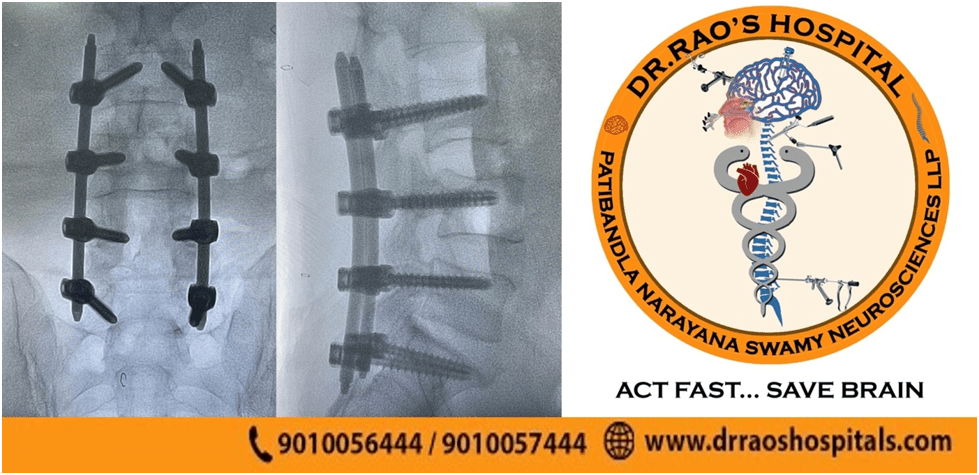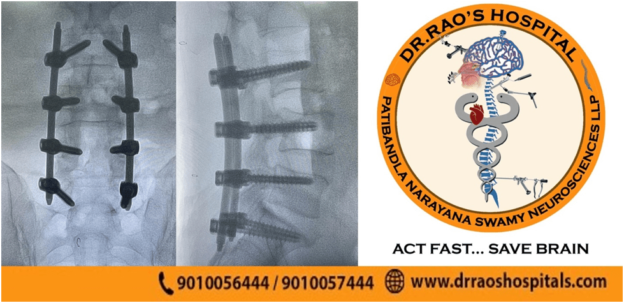Low Back Pain – Get The Best Spine Surgery In Guntur
Back pain is one of the most common health complaints, affecting up to 80% of people at some point in their lives. The low back is the area between the bottom of the ribcage and the top of the legs. Pain caused by several factors, including muscle strain, arthritis, disc problems, and spinal stenosis. Treatment for low back pain often includes pain medication, physical therapy, exercise, and Surgery. Dr. Rao’s hospital is the best spine surgery hospital in Guntur; it will efficiently deal with all your spine problems, including low back pain, either with conservative treatment or minimally invasive spine surgery.
Low back pain is not unique. Low back pain is called chronic low back pain if it persists for over three months. Low back pain is temporary in 90% of the cases and improves without Surgery. In 50% of low back pain patients, it is primarily recurrent during the first year. The lumbar spine (lower back) comprises five vertebral bones and five discs with five pairs of nerves. Discs work as shock absorbers. In a recent mayoclinic.
Causes of Low Back Pain
- Trauma – Sprains & Strains, Fracture
- Herniated Disc
- Tumors
- Infections
- Degenerative disease – spondylosis
- Lumbar Spinal Stenosis
- Osteoarthritis
- Scoliosis
Symptoms of Low Back Pain
It may constitute lower back pain only called lumbago or radiating down the buttocks, hips, and legs, which is called sciatica. The pain can vary from dull, sharp, burning, aching, or a combination. It can be intermittent, constant, or activity-related.
When to Seek Neurosurgeons advice
Even though low back pain is frequently common, some characteristics warrant the evaluation. Neurosurgeon advice is necessary when the pain is persistent or worsening for more than six weeks or; the presence of neurologic symptoms like weakness, numbness, or bowel or bladder incontinence (loss of voluntary control over the voiding or defecation).
Diagnosis of Low Back Pain
The neurosurgeon diagnoses low back pain based on patient history, symptoms, signs, and diagnostic radiological tests. Most patients are treated nonsurgically; Lowback pain needs imaging if the conservative management fails.
- X-rays
- Discography
- Selective Nerve Root Block
- Electromyography (EMG)
- Nerve Conduction Studies (NCS)
- CT or CAT scan
- Magnetic Resonance Imaging (MRI)
- Myelogram
Conservative Treatment
Physicians recommend six weeks of nonsurgical therapy before considering Surgery.
Physiotherapy,
Exercises,
Weight loss,
Local anesthetic and Steroid injections in epidural space or into facets
NSAIDS,
Three days of limited activity, but not bed rest.
All the options mentioned above are aimed at relieving inflammation and irritation of nerve roots.
Red flags for immediate treatment for low back pain are trauma due to accident, a fall, or sports injury or the presence of neurologic symptoms, including numbness, tingling, weakness, or bowel and bladder incontinence.
When Low back pain needs Surgery?
When red flag signs present as mentioned above or worsening low back pain with conservative treatment, it is an indication for Surgery.
- Difficulty standing or walking
- No comorbidities
- Back and leg pain impairs quality of life
- Medication and physical therapy are ineffective
- Increasing neurologic deficits develop, including leg weakness, numbness, or tingling
- Loss of normal bowel and bladder functions
low back Pain Surgery
Neurosurgeons at Guntur, Dr. Rao’s hospital have several options to relieve nerve root pressure. Based on the fact how many nerve roots are involved,
How much degeneration is present and
The presence or absence of instability in the spine, the neurosurgeon would offer:
- A minimally invasive spine surgery.
- Open decompression.
- Decompression and fusion with bone grafts and stabilization with instrumentation, including screws, rods, and different types of cages, based on the extent of the disease.
Following low back pain surgery , patients may regain the ability to bend over. Patients often require post-operative physiotherapy. Any surgical intervention should weigh the benefits and risks involved and explain to the patient to get proper consent in an understandable native language.
Follow-up
Suppose back pain resolves with nonsurgical, conservative treatment. In that case, follow-up will likely be on an as-needed basis or if symptoms return. If a patient undergoes Surgery, follow-up is initially for suture removal at 7 to 14 days, then six weeks, then three months, and doubling the interval later. The neurosurgeon should follow the instrumentation with a radiological workup.
Dr. Rao’s hospital has the best neurosurgeon in Guntur, the best spine specialist, and is the best spine surgery hospital. They offer minimally invasive spine surgery that is safe and effective. Call us at 9010056444 or 9010057444 for any back pain related complaints or to get an appointment.


